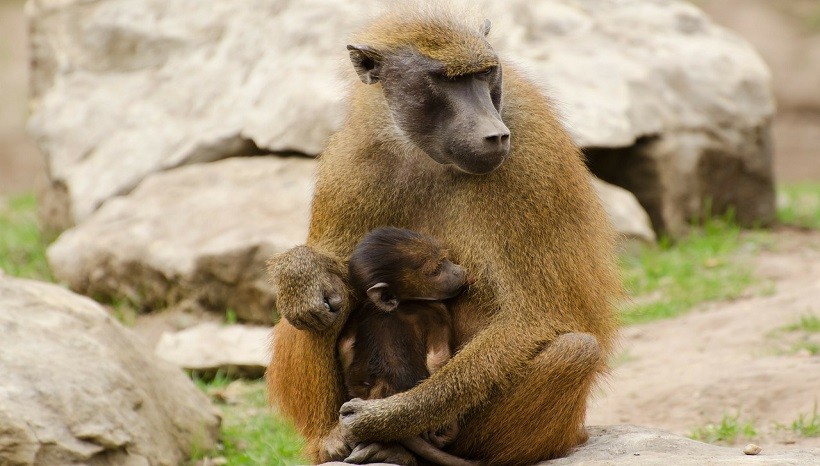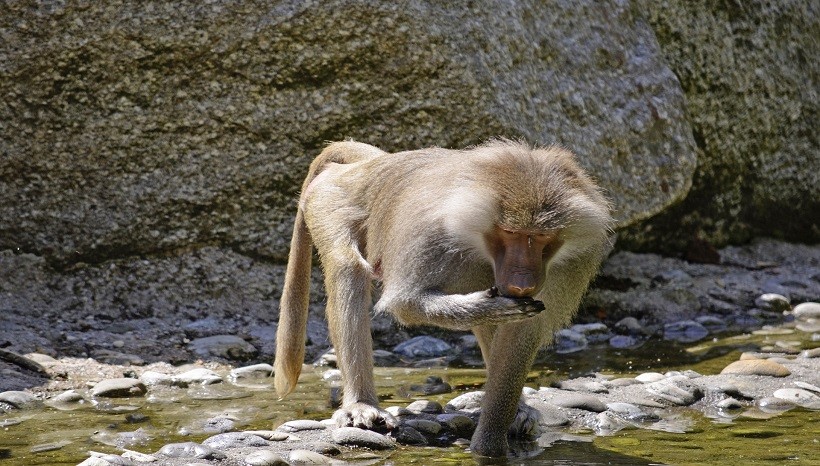Guinea Baboon belongs to the family of Old World Monkey with the scientific name P. Papio. According to the older classifications, there were only two species named genus Hamadryas and Papio baboons. However, Papio species are the subspecies of P.Papio, which is called savanna baboon. It is one of the smallest Baboons belonging from the small region of Africa. They live in forests, woodlands, grasslands, and savannas. The monkey is also called red-toned coats. They come up with excellent communicative skills, including touch, expressions, calls, and postures as well. They are threatened due to the cutting down of lands where they live.
Guinea Baboon Appearance

This monkey has large bodies but faces sexual dimorphism and long canines. It has broad incisors and long molars. However, the front and back limbs are of the same length with short digits. These primates can’t climb and have an excellent social system. It is covered with a reddish-brown coat and has wavy hair. They do not have hair at the hindquarters. Furthermore, their face is black with the sideburns yellowish-brown in color.
Guinea Baboon Lifespan
The Guinea Baboon Lifespan is of 35-45 years. However, they live more in captivity due to adequate care and protection from predators.
Guinea Baboon Diet
This species can eat all the food which is available to them. Following are the diet of this Baboon:
Guinea Baboon Weight
It has 13-26 kg weight and the smallest of all the baboons. However, males are heavier than females.
Guinea Baboon Habitat

You can find this monkey in Africa in different areas, including Senegal, western Mali, Gambia, Guinea. Mostly they are in the savannah and forests of sub-Saharan Africa. These monkeys also live in rain forests, grasslands, and other areas.
Baboon Species
Following are the Baboon Species:
These species belong from different areas of Africa. However, hamadryas baboon is found in some parts of the Arabian Peninsula. The baboons are the largest primates who existed in the world for two million years, at least.
- Related: Rhesus Macaque
- Related: Proboscis monkey Facts, Habitat, pics and All Information
FAQ
1. What does a guinea baboon eat?
They eat fruits, grass, roots, insects, mammals, seeds, leaves, and invertebrates.
- Related: Emperor Tamarin
- Related: Golden Lion Tamarin Facts, Diet, Habitat and Pictures
2. Are guinea baboons endangered?
According to the international union for conservation of nature and natural resources red list of threatened species, the Guinea baboon is not endangered.
3. How dangerous is a baboon?
They are rarely dangerous to humans but can bite the dogs. However, they frighten the people, especially women in urban areas.
4. Does guinea baboon live in a group?
The monkey has a habit of living in troops consisting of 200 individuals. Due to this, they can stay safe from dangerous predators.
- Related: Mandrill vs Baboon
- Related: Golden Monkey Facts, Diet, Habitat and All Information
Conclusion
Guinea baboon is found in different areas of Africa that live in woodlands, grasslands, savannah, and forests as well. They have large bodies but contain sexual dimorphism, which is expressed by long canines. Their gestation period is of 183 days and smallest as compared to others. They spend most of the time at the ground because the monkey can’t climb like others. The monkey is active in the daytime and goes to the palm or kapok trees to find the safest place for sleep. They communicate by using different physical interactions and vocalizations as well.
If you want to learn more about pets visit us at petshoods
{ "@context": "https://schema.org", "@type": "Article", "mainEntityOfPage": { "@type": "WebPage", "@id": "https://petshoods.com/guinea-baboon-facts-habitat-and-all-information/" }, "headline": "Guinea Baboon Facts, Habitat and All Information", "description": "Guinea baboon is found in different areas of Africa. They live in woodlands, grasslands, savannah, and forests. They have large bodies but contain sexual dimorphism, which is expressed by long canines.", "image": "https://petshoods.com/wp-content/uploads/2020/09/Guinea-Baboon-Facts-Habitat-Diet-and-All-Information-768x436.jpg", "author": { "@type": "Person", "name": "jeremy" }, "publisher": { "@type": "Organization", "name": "Petshoods", "logo": { "@type": "ImageObject", "url": "https://petshoods.com/wp-content/uploads/2019/02/13925402_1502331219793083_1620090286454245017_n.jpg" } }, "datePublished": "2020-09-16", "dateModified": "2021-07-13" } { "@context": "https://schema.org/", "@type": "ItemList", "itemListElement": [ { "@type": "ListItem", "position": 1, "name": "Guinea Baboon Appearance", "url": "https://petshoods.com/guinea-baboon-facts-habitat-and-all-information/#Guinea_Baboon_Appearance" }, { "@type": "ListItem", "position": 2, "name": "Guinea Baboon Lifespan", "url": "https://petshoods.com/guinea-baboon-facts-habitat-and-all-information/#Guinea_Baboon_Lifespan" }, { "@type": "ListItem", "position": 3, "name": "Guinea Baboon Diet", "url": "https://petshoods.com/guinea-baboon-facts-habitat-and-all-information/#Guinea_Baboon_Diet" }, { "@type": "ListItem", "position": 4, "name": "Guinea Baboon Weight", "url": "https://petshoods.com/guinea-baboon-facts-habitat-and-all-information/#Guinea_Baboon_Weight" }, { "@type": "ListItem", "position": 5, "name": "Guinea Baboon Habitat", "url": "https://petshoods.com/guinea-baboon-facts-habitat-and-all-information/#Guinea_Baboon_Habitat" }, { "@type": "ListItem", "position": 6, "name": "Baboon Species", "url": "https://petshoods.com/guinea-baboon-facts-habitat-and-all-information/#Baboon_Species" } ] } { "@context": "https://schema.org", "@type": "FAQPage", "mainEntity": [{ "@type": "Question", "name": "What does a guinea baboon eat?", "acceptedAnswer": { "@type": "Answer", "text": "They eat fruits, grass, roots, insects, mammals, seeds, leaves, and invertebrates." } },{ "@type": "Question", "name": "Are guinea baboons endangered?", "acceptedAnswer": { "@type": "Answer", "text": "According to the international union for conservation of nature and natural resources red list of threatened species, the Guinea baboon is not endangered." } },{ "@type": "Question", "name": "How dangerous is a baboon?", "acceptedAnswer": { "@type": "Answer", "text": "They are rarely dangerous to humans but can bite the dogs. However, they frighten the people, especially women in urban areas." } },{ "@type": "Question", "name": "Does guinea baboon live in a group?", "acceptedAnswer": { "@type": "Answer", "text": "The monkey has a habit of living in troops consisting of 200 individuals. Due to this, they can stay safe from dangerous predators." } }] }